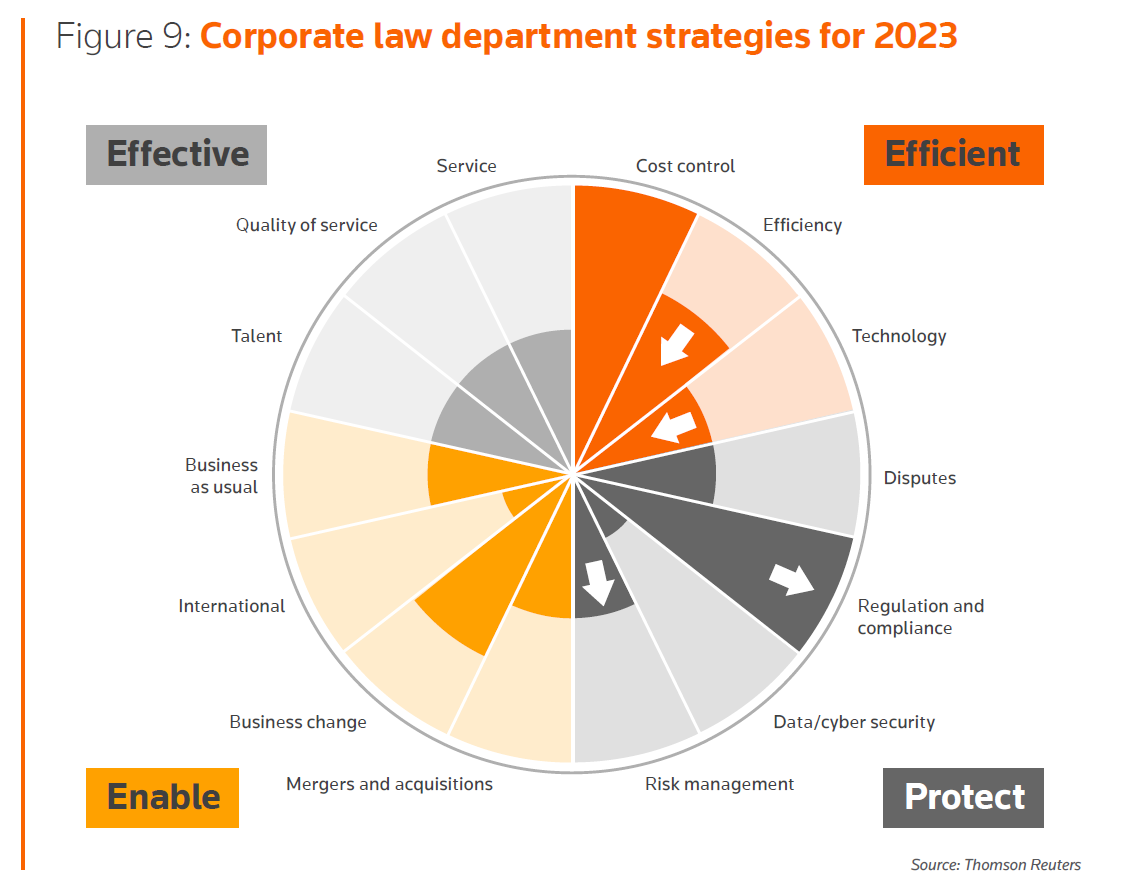At a recent Reuters event, leaders from corporate law departments discussed how they were managing the push for efficiency and the need to adopt the best legal tech
DALLAS — Today’s cadre of corporate law department leaders are seeking to ready their teams for a future that may look much different than it does today, one that’s built on more efficiency of their work processes, largely by adoption of advanced technology and tools that are only now beginning to see widespread use.
During a roundtable session at Reuters’ recent Legal Leaders USA event, a large contingent of corporate legal leaders — general counsel, assistant GCs, and legal operations professionals — discussed what they are looking for in terms of new efficiencies and technological solutions within their departments and how more advanced tech tools like ChatGPT and generative artificial intelligence (AI) will impact corporate law.
Indeed, in the Thomson Reuters Institute’s recently published 2023 State of the Corporate Law Department report, corporate law department leaders said their main priorities fall into four categories:
-
-
-
- safeguarding their company from risk;
- driving the overall success of the business;
- delivering sound legal advice; and
- making the best use of limited resources.
-
-

While many corporate law departments are experiencing a shift from a focus on efficiency to a focus on protecting the business, the search for efficiencies and the manner in which they can be achieved is still top of mind for many of those in attendance at the Legal Leaders event.
In fact, much of the discussion centered on the latest innovations and technological solutions that are being used across the board. Attendees really wanted to hear from their peers about what tools, processes, or new technologies they were using, why they had chosen those solutions, and — most importantly — what was working as envisioned for the law department?
That achieving greater efficiency was a top priority was not surprising, given that many attendees self-identified as being newer to their roles, with many of them joining as part of their company’s dedicated ramp-up in legal operations. In fact, many of them said they had either just been hired into legal ops within the last year or were themselves creating a legal ops team. In most cases, they had been given a mandate to look for ways to create greater efficiency within the legal function, including identifying ways to automate the department and employ the right legal technology to move the ball forward.
Interestingly, one of the tech solutions most discussed by the group was Contract Lifecycle Management (CLM) systems, a wide-ranging platform that can cover everything from contract automation to intake and process management. Many attendees said it was important to identify what problems your department is trying to solve before trying to implement a CLM system, because the tool isn’t a one-size-fits-all solution, and there’s a lot of functionality that falls under the CLM umbrella.
First, some advised, you need to identify your greatest need; or determine what would be a good challenge to tackle first. Indeed, one participant said their CLM allowed them to move from automating the contract in-take process to then allowing them to serve their internal clients more quickly and track how they were spending their time more effectively. Their CLM system also allowed end-users to delve into a lot of data about what the law department was doing and how it was doing it, ultimately helping them refine their processes.
Adoption & implementation are key
From there, not surprisingly, the group talked about the critical issues of adoption and implementation of new technology and, most importantly, how difficult (or not) it was to drive that change.
One attendee discussed how their team sought to make the department’s new in-take site more user-friendly so internal clients would have an easier time with it. The department also had to make sure that people were aware of this new solution. In fact, showing potential users the clear advantages that the new solution has over the previous way of doing things can make all the difference, the attendee said.
Another participant noted that once the team showed users company-wide that they could click on a pull-down on the CLM platform to access a self-serve non-disclosure agreement form and that they didn’t have to wait three days in queue for one, it became a huge selling point that got people across the company engaged in using the platform.
Once users became aware of the ease-of-use of the new platform, several attendees said it was their experience that people around the company started joining in with other tasks that they found they could now more easily complete. Importantly, attendees agreed, department leaders need to work internally to help any new tech adoption from its onset by demonstrating what’s in it for the end-user and — even more critically — by making the value pitch to management. Both of these strategies are key factors in terms of getting to a point where the new technology is being utilized much more regularly across the company.
The future of legal tech
Not surprisingly, the group also was eager to discuss the impact that ChatGPT and generative AI on legal and what role those advanced tech tools may have in the industry. For instance, recent headlines suggested that 40% of legal jobs could go away because of such technology, and while that seemed to worry many attendees, some were quick to point out that they’ve heard that before. Indeed, several said that other past technologies — such as online legal research, for example — were supposed to have a similar effect on the legal world, but instead, the profession just adapted to these innovations and found they could work faster and more effectively by using them.
Other participants stressed that the human element is still a critical component in legal services. While online legal research made lawyers more efficient at finding primary information, for example, the task still required the application of human judgment and interpretation of what was being viewed.
New technology always allows the industry to take a step forward, many agreed, but often, especially when you’re talking about all things legal, it opens up new questions that need to be answered by experts. And certainly, with generative AI and ChatGPT, there will be all kinds of legal ramifications that need to be contemplated and will impact everything from regulations to corporate policy, leaving lawyers at the forefront to navigate many of those challenges.
Finally, when the group took up the question of what the legal landscape would look like in five years, one legal specialist noted an old saying that holds, “If you can think of it, then it will happen sooner than you think.”
To many discussion participants, that meant that change is coming to the legal profession at a more rapid pace than many industry experts may predict — and legal leaders are going to need to be prepared for it. As one attending legal leader quipped: “Buckle up, because it’s gonna happen!”







